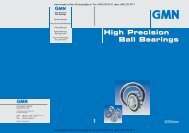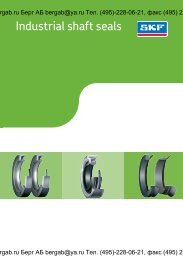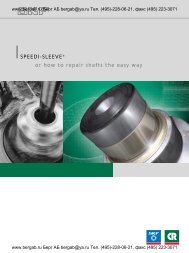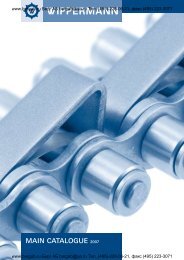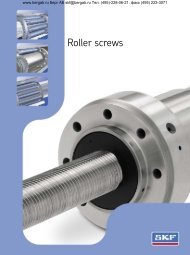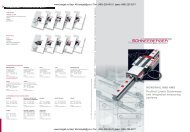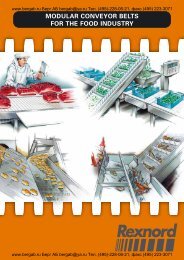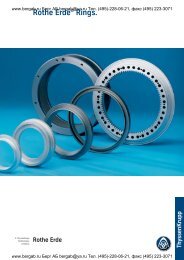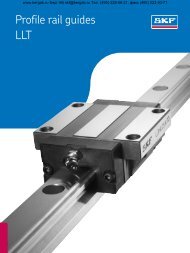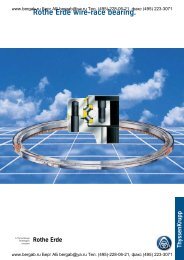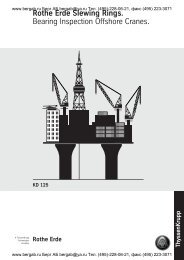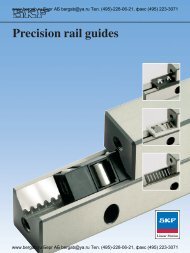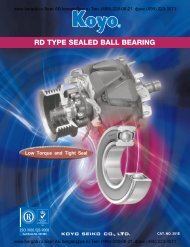TSUBAKI EMERSON CAM CLUTCH
TSUBAKI EMERSON CAM CLUTCH
TSUBAKI EMERSON CAM CLUTCH
Create successful ePaper yourself
Turn your PDF publications into a flip-book with our unique Google optimized e-Paper software.
www.bergab.ru Берг АБ bergab@ya.ru Тел. (495)-228-06-21, факс (495) 223-3071<br />
■ MODES OF OPERATION<br />
<strong>TSUBAKI</strong> Cam Clutches are precision devices which lock to transmit torque in one direction of rotation, but<br />
overrun (freewheel) in the opposite direction of rotation. All the series of clutches utilize the same principles of<br />
operation. Since clutch applications encompass a variety of load and speed characteristics, <strong>TSUBAKI</strong> Cam<br />
Clutches are manufactured in a range of capacities and styles, which are designed to provide the best functional<br />
characteristics for performing in the following three basic modes of operation:<br />
1. General overrunning<br />
Clutches used in this type of application overrun at<br />
either the inner or outer race during the majority of the<br />
clutch operating time, and are occasionally called<br />
upon to lock up and drive. A typical application is a<br />
two-speed drive, where an electric motor and a<br />
geared motor are connected to a single driven shaft<br />
through one-way clutches. The machine can be driven<br />
by either the electric motor or geared motor. When the<br />
geared motor drives at low speed, the clutch<br />
engages. When the electric motor drives the machine,<br />
the clutch overruns. The clutch automatically switches<br />
between low speed and high speed.<br />
2. Indexing<br />
In this mode of operation, reciprocating motion<br />
applied to the driving race of the clutch is transformed<br />
into unidirectional intermittent motion, at the driven<br />
race. For example, on a feeding roller, the clutch is<br />
mounted on the roller and a torque arm is connected<br />
to the driving race of the clutch. A crank motion<br />
mechanism provides reciprocating motion to the<br />
driving race. The clutch drives in the forward stroke<br />
(index) and overruns on the return stroke, resulting in<br />
intermittent unidirectional motion of the feeding roller.<br />
3.Backstopping<br />
In backstop applications, the clutches are used to<br />
prevent reverse rotation of drive shafts, which may<br />
cause damage to machinery and other expensive<br />
equipment. With the outer race of the clutch anchored<br />
stationary, the inner race can overrun freely in one<br />
direction of rotation. Reverse rotation is<br />
instantaneously prevented by the automatic<br />
engagement of the clutch. Typical backstop<br />
applications are in conveyor systems and gear<br />
reducers.<br />
General Overrunning<br />
Indexing<br />
Backstopping<br />
Air cleaning plants<br />
Agricultural machines<br />
Bucket elevators<br />
Compressors<br />
Conveyors<br />
Cranes and hoists<br />
Dry cleaning machinery<br />
Duplicator equipment<br />
Fish net machines<br />
Typical Applications<br />
Heat-treatment furnaces<br />
Induced draft fans<br />
Multi-state conveyors<br />
Packaging machinery<br />
Printing machinery<br />
Pumps<br />
Punch presses and feeders<br />
Power plants<br />
Refinery equipment<br />
Speed reducers<br />
Standby power units<br />
Textile looms<br />
Two-speed grinders<br />
Two-speed shiftovers<br />
Washing machines<br />
Wire winding machinery<br />
www.bergab.ru Берг АБ bergab@ya.ru Тел. 6 (495)-228-06-21, факс (495) 223-3071



